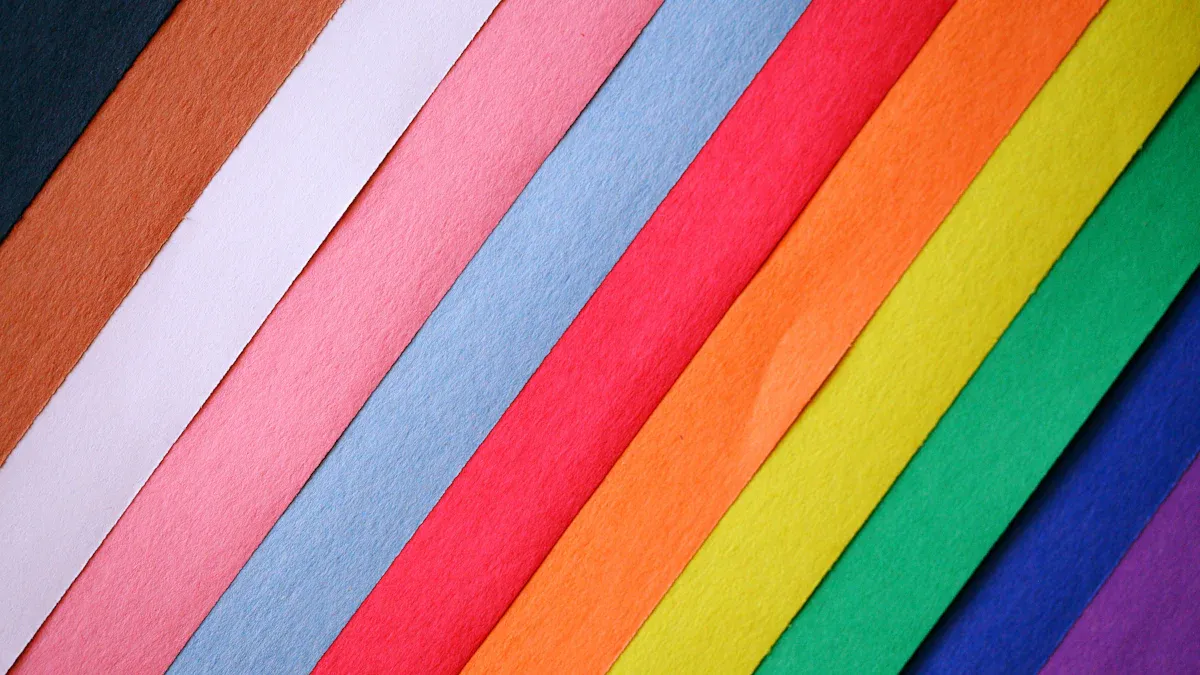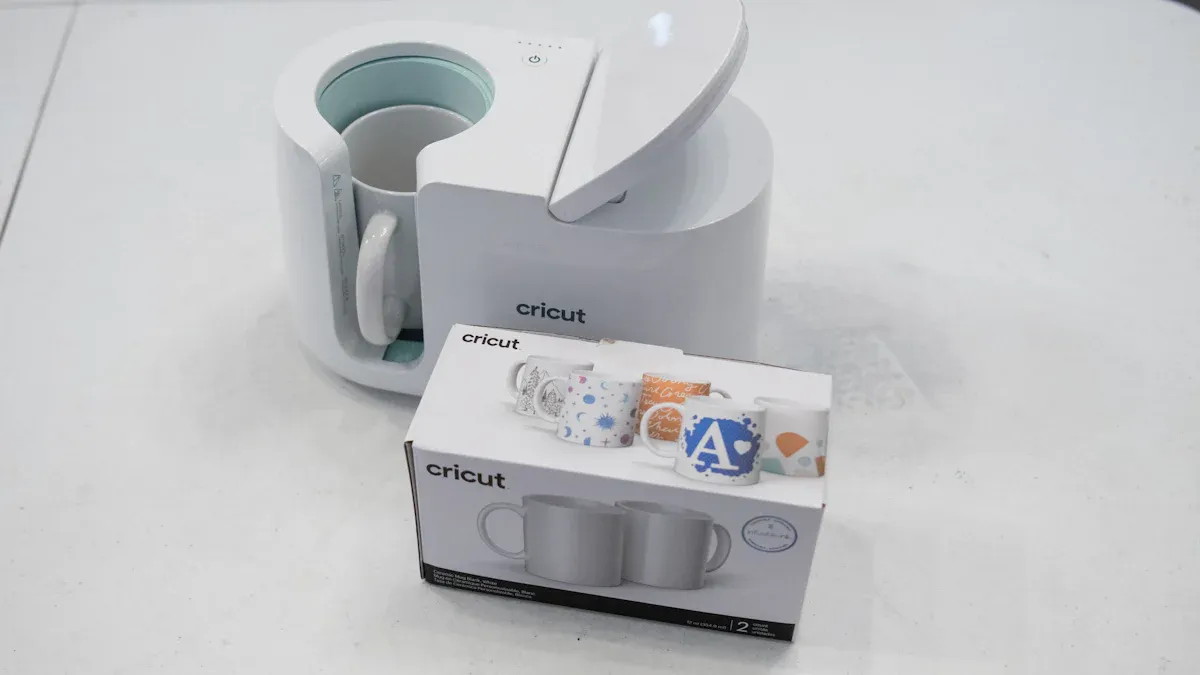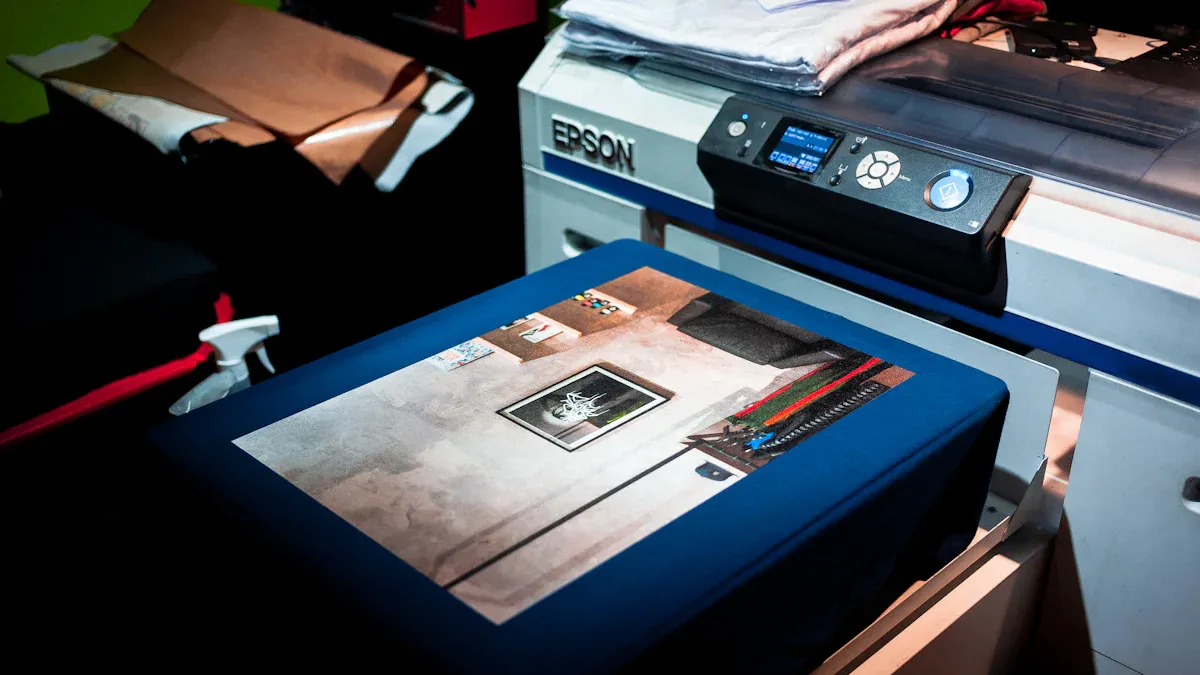
When you look at sublimation blanks and heat transfer vinyl, there are big differences. The main differences are the materials you can use, how the finished item feels, and how you make it. Many people use these ways to make custom printed things. Each way needs its own materials and tools. Sublimation blanks only work with polyester or special coated surfaces. This gives a smooth and soft finish that lasts a long time. Heat transfer vinyl works on more things, like cotton or blends. But it adds a layer you can feel. Look at this table to see how these choices compare for your custom projects:
Aspect | Sublimation Blanks | Heat Transfer Vinyl (HTV) |
|---|---|---|
Material Compatibility | Polyester/polymer-coated only | Cotton, polyester, blends, more |
Print Integration | Ink bonds into material | Vinyl sits on top |
Feel | Soft, seamless | Textured, less soft |
Durability | Highly durable, permanent | Less durable, may crack or fade |
Key Takeaways
Sublimation works best on polyester or coated things. It makes prints that are bright, soft, and last a long time.
Heat transfer vinyl works on many fabrics like cotton and blends. It comes in many styles but adds a layer you can feel.
Sublimation needs special printers and blanks. It is better for big projects with full-color designs.
Heat transfer vinyl uses simple tools. It is good for small projects with bold, simple designs and cool effects.
Pick sublimation for detailed photos and strong prints. Choose heat transfer vinyl for more choices, easy use, and many materials.
Sublimation Blanks Overview

What Are Sublimation Blanks
Sublimation blanks are the base for dye sublimation projects. These blanks are made from materials that work with sublimation printing. You can get them as t-shirts, mugs, keychains, or mouse pads. Each blank has a special coating or lots of polyester. This makes them great for dye sublimation. When you use sublimation blanks, your prints look bright and last long.
Tip: Always check if your blank says it is for dye sublimation. This helps the print stick well and last longer.
Compatible Materials
Not all materials work for dye sublimation. You need to pick things that let the ink bond during the process. Here are some good choices:
Polyester fabrics (like t-shirts, hoodies, and sublimated apparel)
Coated ceramics (such as mugs and plates)
Sublimation-ready plastics and woods
Metal items with a special coating
Polyester is the best choice. Its chemical structure lets the dye sublimation ink go deep into the fibers. You get bright colors and a soft feel. Cotton does not work well for sublimation because the ink cannot bond right. The process needs the right materials to get the best results.
Sublimation Printing Process
You follow steps for sublimation printing to make your designs. The dye sublimation process uses heat and pressure to turn solid ink into gas. This gas bonds with the polyester or coated surface. Here is how you do it:
Make your image using graphics software.
Print the image on special transfer paper with a dye sublimation printer.
Put the transfer paper and blank into a heat press machine.
Use heat (usually between 300°F and 400°F) and pressure.
The ink turns into gas and goes into the blank.
Let the item cool. The image becomes part of the material.
This process makes the print strong and bright. You do not feel the design because the ink is inside the blank. Dye sublimation printing works best with polyester and coated blanks. You need a heat press, a printer with sublimation ink, and the right blanks to start.
Heat Transfer Vinyl Basics

What Is Heat Transfer Vinyl
Heat transfer vinyl is an easy way to put designs on things. It has glue on one side that sticks when heated. You use a heat press machine to make the vinyl stick to your item. First, you make your design on a computer. Next, you cut the design out of the vinyl sheet with a vinyl cutter. The vinyl has a shiny side that holds your design and a dull side with glue. You need to flip your design before cutting. The glue side will touch the fabric when you press it.
Here is how you use heat transfer vinyl:
Make your artwork and flip it.
Cut the vinyl with a vinyl cutter.
Remove extra vinyl, leaving your design.
Put the design on your item.
Use a heat press to add heat and pressure.
Take off the carrier sheet after pressing.
Heat transfer vinyl comes in many styles. You can get glossy, matte, glitter, flock, or glow-in-the-dark. These choices help you make cool and different projects.
Compatible Materials
You can use heat transfer vinyl on many things. Cotton, polyester, and blends work best. Canvas and denim are also good choices. Some vinyl types stick to leather, nylon, and Lycra. Most Siser heat transfer vinyl uses polyurethane. This makes it safe for kids’ clothes. You can print on t-shirts, bags, hats, and more with these materials.
Tip: Always read the label on your vinyl. It tells you which items work best. Some vinyl needs special settings for some fabrics.
Application Methods
There are a few ways to use htv. The most common way is with a heat press machine. This gives even heat and pressure. It helps the vinyl stick well to your item. You can use a home iron, but a heat press works better for most projects.
Here is a table that shows how heat transfer vinyl compares to another method:
Aspect | Heat Transfer Vinyl (HTV) | Direct to Film (DTF) |
|---|---|---|
Design Preparation | Flip design, cut with vinyl cutter | Print on film, no flipping needed |
Application Steps | Cut, remove extra, place, heat press (300-320°F for 10-15s), peel, wait 24h | Print, add powder, cure, place, heat press (320°F for 15-20s), peel, cure again |
Equipment Needed | Vinyl cutter, heat press machine | DTF printer, powder tool, heat press, curing oven |
Fabric Suitability | Best for cotton, polyester, blends | Works on more types, even stretchy and heat-sensitive fabrics |
Texture and Feel | You can feel the vinyl, thicker texture | Softer, more bendy finish |
Durability | Lasts long, but may crack or peel after many washes | Often lasts longer, keeps details and colors better |
Design Complexity | Only as many colors as vinyl sheets, multi-color needs more presses | Good for detailed, multi-color designs |
Cost-Effectiveness | Good for small jobs or one shirt | Costs more to start, better for big or complex jobs |
You can pick the best way to use htv for your project. If you want to print on cotton or polyester, heat transfer vinyl gives you lots of choices and styles.
Sublimation vs Heat Transfer Vinyl
Process Comparison
When you compare sublimation and heat transfer vinyl, the steps are very different. Dye sublimation uses heat and pressure to change solid ink into gas. The gas sticks to polyester or a coated surface. You print your design on special paper. Then you put the paper on the blank and use a heat press. This process is more technical. You must learn about colors and how to set up your equipment. Sublimation printing is good for making lots of items fast after you set up your design.
Heat transfer vinyl works in another way. You cut your design from a vinyl sheet. You pull away the extra vinyl. Then you press the design onto your item. This takes longer for each piece, especially if you use many colors or layers. You must cut, weed, and press each color by itself. This makes heat transfer vinyl better for small projects or when you want special looks like glitter or flock.
Aspect | Sublimation Printing | Heat Transfer Vinyl (HTV) |
|---|---|---|
Time | Slower for multi-color | |
Complexity | Technical, needs skill | Manual, more steps |
Skill Level | Beginner-friendly |
Tip: If you want to make lots of shirts with full-color pictures, dye sublimation is faster. For small groups or simple designs, heat transfer vinyl is easier to start.
Equipment Needed
The tools you need are also different for sublimation and heat transfer vinyl. For dye sublimation, you need a special printer, inks, transfer paper, and a heat press. These tools cost more at the start. You also need blanks that work with sublimation, like polyester shirts or coated mugs.
Heat transfer vinyl needs fewer tools. You only need a vinyl cutter, vinyl sheets, and a heat press or even a home iron. It costs less to start, so it is good for beginners or small businesses. You can use many kinds of blanks, like cotton shirts, canvas bags, or hats.
Equipment Aspect | Sublimation Printing | Heat Transfer Vinyl (HTV) |
|---|---|---|
Printer Needed | Yes (sublimation printer) | No |
Vinyl Cutter Needed | No | Yes |
Heat Press Needed | Yes | Yes (or iron for small jobs) |
Special Blanks | Yes (polyester/coated) | No (works on many fabrics) |
Start-up Cost | High | Low |
Note: The tools you need can change your budget and what you can make. Think about how much you want to spend and how many things you want to make before you pick a method.
Design and Color Options
Design and color choices are also different for dye sublimation and heat transfer vinyl. Dye sublimation lets you print full-color pictures, photos, and designs with shading or faded edges. You get bright colors that last and blend well. This works best on light polyester or coated items. You cannot use sublimation on dark fabrics or 100% cotton.
Heat transfer vinyl is good for simple designs, words, and shapes with up to three colors. You can stack vinyl for more colors, but too many layers make it thick and stiff. HTV comes in many styles, like glitter, shiny, or patterns. You can use it on cotton, polyester, canvas, and even leather. It works on both dark and light items.
Aspect | Heat Transfer Vinyl (HTV) | Sublimation Printing |
|---|---|---|
Full-Color Graphics | No | Yes |
Shading/Gradients | No | Yes |
Special Finishes | Yes (glitter, flock, etc.) | No |
Substrate Colors | Any (light/dark) | Light only |
Substrate Types | Many fabrics | Polyester/coated |
If you want to print photos or full-color art, dye sublimation is best. For bold, simple designs or special textures, heat transfer vinyl gives you more choices.
Durability and Longevity
How long your design lasts is important when picking a method. Dye sublimation prints last a long time because the ink goes into the fabric. The design will not crack, peel, or fade, even after many washes. You get strong results, especially on polyester shirts or coated mugs. Sublimation printing can last over five years on fabric and even longer on hard items if you take care of them.
Heat transfer vinyl sits on top of the fabric. Over time, the vinyl can crack, peel, or fade, especially if you wash it a lot. Most HTV designs last one to three years with normal use. It does not last as long as sublimation, but you can still get good results if you follow the care rules.
Dye sublimation gives the best lasting results for full-color designs.
Sublimation prints do not fade, crack, or peel.
Heat transfer vinyl does not last as long and may show wear after many washes.
Printing Method | Average Lifespan on Fabrics | Durability Characteristics | Notes |
|---|---|---|---|
Sublimation | High durability; ink bonds into fabric, resistant to cracking, peeling, and fading | Best on polyester; wash in cold water | |
Heat Transfer Vinyl (HTV) | 1–3 years | Medium durability; prone to peeling and cracking | Works on many fabrics; less resistant to wash and fade |
For projects where you want your design to last, dye sublimation is the best pick. If you want to try many fabrics or change designs often, heat transfer vinyl is a flexible choice.
Pros and Cons
Sublimation Pros and Cons
When you look at the pros and cons of sublimation, you see why many people choose this method for custom products. Sublimation gives you high image quality. Your designs stay sharp and do not lose detail. You can print full-color images, photos, and complex art with ease. The ink bonds deep into the material, so your prints do not crack, peel, or fade over time. You get long-lasting results, especially on polyester shirts, mugs, or coated items.
Note: You need special blanks for sublimation. These must be polyester or have a polyester coating.
Here are the main pros and cons of sublimation:
You get bright, permanent prints that last for years.
You can print on many items like mugs, shirts, and phone cases if they have the right coating.
You need special equipment, such as a sublimation printer and heat press.
Sublimation only works on polyester or coated surfaces. You cannot use it on cotton.
The cost per item can be higher than other methods.
Pros of Sublimation | Cons of Sublimation |
|---|---|
High image quality | Limited to polyester/coated items |
Durable, does not fade | Higher start-up cost |
Full-color design options | Not for cotton or dark fabrics |
Heat Transfer Vinyl Pros and Cons
You may want to know the pros and cons of heat transfer vinyl before starting your project. Heat transfer vinyl is easy to use. You can start with simple tools and learn quickly. This method lets you add names, logos, or images to many fabrics, such as cotton, polyester, blends, and even canvas or leather. You can use specialty vinyl for glitter, metallic, or holographic effects. Heat transfer vinyl is great for small runs and custom orders. It is also budget-friendly for beginners and small businesses.
Tip: Always follow the right heat, pressure, and time settings to get the best results with heat transfer vinyl.
Here are the main pros and cons of heat transfer vinyl:
You can personalize almost any fabric or even hard surfaces like wood and mugs.
The process is simple and does not need much training.
You get strong, professional results that last through many washes.
You can use many types of vinyl for different looks.
If you do not apply it right, the vinyl may peel or crack.
Layering many colors can make the design thick and hard to wear.
Some specialty vinyl needs extra care.
Pros of Heat Transfer Vinyl | Cons of Heat Transfer Vinyl |
|---|---|
Works on many fabrics and surfaces | Can peel or crack if not applied well |
Easy for beginners | Layering can be tricky |
Many finishes and effects | Some finishes need special care |
Cost-effective for small projects | Bulk designs take more time |
When you compare the pros and cons of heat transfer vinyl and sublimation, you can see that each method has its own strengths. You should think about your project needs, the materials you want to use, and how long you want your designs to last.
Choosing the Right Method
Best Uses for Sublimation
Pick sublimation printing if you want bright, lasting designs. It works best on polyester or coated things. This way is great for custom projects with full-color pictures. You can use it for shirts, mugs, plaques, and more. The table below shows which materials and projects work well:
Material Type | Custom Project Types | Tips for Best Results |
|---|---|---|
Polyester Fabrics | Custom shirts, team uniforms | Use lots of polyester for bright, strong prints |
Ceramic with polymer coating | Personalized mugs, coasters | Pick smooth coatings for images that last |
Aluminum sheets with coating | Awards, decorative signs | Check for coating problems before you print |
Glass with sublimation coating | Custom drinkware, glass gifts | Be careful not to scratch the glass |
Hard plastic or rubber cases | Custom phone cases | Make sure blanks fit your printer and design |
Metal or acrylic with coating | Keychains, small custom items | Use good blanks for sharp details |
Ceramic, cork, MDF with coating | Home décor, promo products | Use even coatings for smooth prints |
Note: Sublimation printing saves money when you make many items at once. Try different blanks to see what works best for your project.
Best Uses for Heat Transfer Vinyl
Heat transfer vinyl is flexible for many custom jobs. You can use it on cotton, polyester, blends, canvas, or leather. It is good for small orders and bold, simple designs. Here are some common uses: custom t-shirts, hats, and hoodies; sportswear and backpacks; high-visibility signs and outdoor ads.
You can choose from over 50 colors and special effects. These include glitter, holographic, or glow-in-the-dark. Heat transfer vinyl lets you add names, numbers, or logos to almost any fabric. The designs are strong and last through many washes. The process is easy and does not need much training. You can use regular or stretchy vinyl for different things. This makes heat transfer vinyl a top pick for custom clothes and accessories.
Sublimation vs Heat Transfer: Real-World Scenarios
You might wonder which way is best for your project. If you want a shirt with a full-color photo, sublimation printing is best. It gives you bright, smooth images on polyester. If you need to print on cotton or blends, heat transfer vinyl is better. It works well for small orders with bold designs. Heat transfer vinyl is also good for sports uniforms, hats, or bags. You do not need costly tools, and you can use many kinds of blanks.
Sublimation printing is cheaper when you make lots of items. For small jobs or one-of-a-kind things, heat transfer vinyl saves time and money. You get strong color on many fabrics. Pick sublimation for bright, all-over prints on polyester. Choose heat transfer vinyl for custom designs on cotton, blends, or when you want special effects.
Picking between sublimation and heat transfer vinyl depends on what you want to make. The table below shows the main ways they are different so you can choose:
Aspect | Sublimation | Heat Transfer Vinyl (HTV) |
|---|---|---|
Fabric Compatibility | Polyester, light colors | Cotton, blends, more |
Design Complexity | Vibrant, all-over prints | Simple logos, text, numbers |
Finishes | Printed designs only | Glitter, metallic, more |
Production Scale | Great for high-volume, detailed | Best for small, custom projects |
Durability & Feel | Soft, ink in fabric | Textured, durable layer |
Cost & Equipment | Sublimation printer, special inks | Vinyl cutter, heat press |
Knowing these differences makes it easier to pick the right way for your fabric, design, and how much you want to spend. If you want more help, look at the Cricut Heat Guide for easy steps and videos for both methods.
FAQ
What is the main difference between sublimation and heat transfer vinyl?
Sublimation ink becomes part of the material. Heat transfer vinyl sits on top of the fabric. You get a soft feel with sublimation. You feel the vinyl layer with HTV.
Can you use sublimation on cotton shirts?
No, you cannot use sublimation on cotton. Sublimation only works on polyester or items with a special coating. For cotton shirts, use heat transfer vinyl instead.
How do you care for items made with heat transfer vinyl?
Wash items inside out in cold water. Avoid bleach and high heat. Air dry or use a low setting. This helps your design last longer and keeps colors bright.
Which method is better for full-color photos?
You should use sublimation for full-color photos. Sublimation prints detailed images with bright colors. HTV works best for simple shapes and text, not photos.
Do you need special equipment for both methods?
Yes, you need different tools. Sublimation needs a sublimation printer, special ink, and a heat press. HTV needs a vinyl cutter and a heat press or iron.

